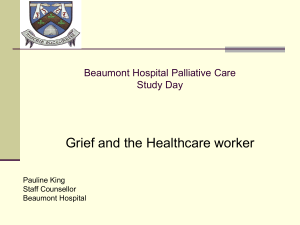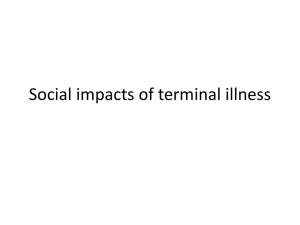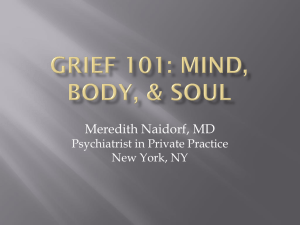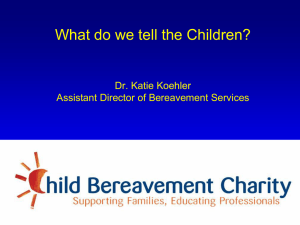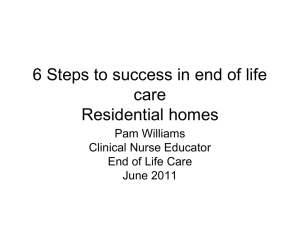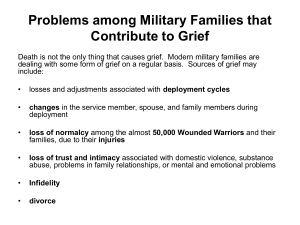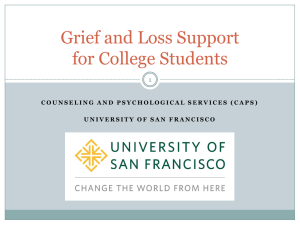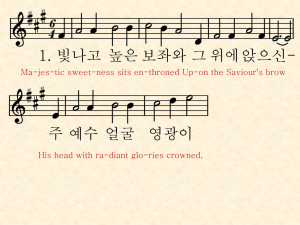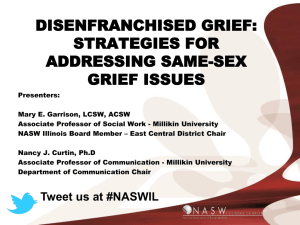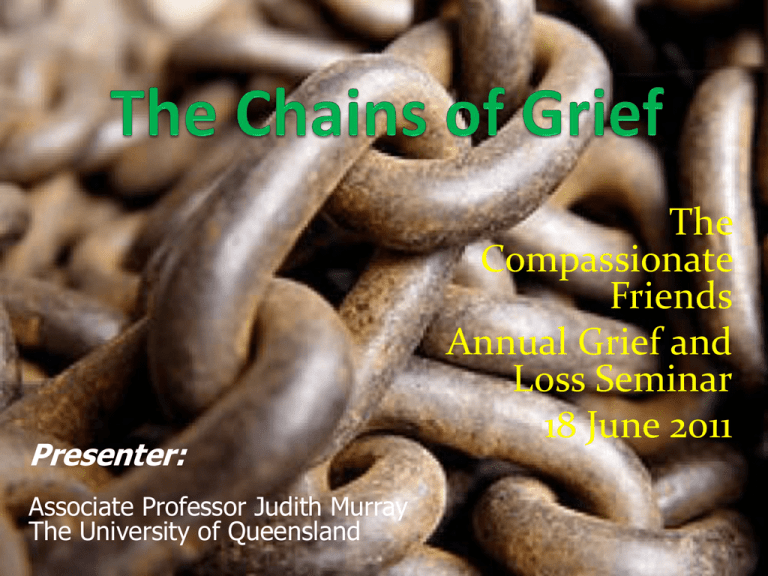
Presenter:
Associate Professor Judith Murray
The University of Queensland
The
Compassionate
Friends
Annual Grief and
Loss Seminar
18 June 2011
The Chains that Bind:
Reminiscence
I hear your whisper on the wind
I hear your voice just as it has always been
Your laughter fills the air around me
And I turn with a smile to laugh with you
But when I turn there is silence
There are only echoes in my mind
I know this, and yet, often they are so loud
So clear, so real, that I just can’t believe you’re not
here
Karen Gerry in‘ Words of Sorrow Words of Love’
The Essence of Our Chains:
The EXPERIENCE of Loss
Experience is not an unstable irrational and emotive
concept but rather it is the world, it is knowing.
Lumby (1994)
Understanding the experience….
An Emic rather than an Etic approach.
It is also you have shared with all humanity...
No one ever told me that grief felt so like fear.
C.S. Lewis 1898-1963
Well has it been said that there is no grief like the grief
which does not speak
Henry Wadsworth Longfellow 1819-1892
Our trials, our sorrows and our grieves develop us.
Orison Swett Marden 1850-1924
What right have I to grieve, who have not ceased to
wonder?
Henry David Thoreau 1817-1862
OTHER DEFINITIONS
Change
Loss is produced by an event which is perceived to be negative by the
individuals involved and results in long-term changes to one’s social
situations, relationships, or cognitions.
Miller and Omarzu (1998)
Bereavement is the loss through death of a significant other.
Grief is
• “the emotional response to loss: the complex amalgam of painful
affects including sadness, anger, helplessness, guilt and despair.”
Raphael (1984)
• (Grief) incorporates diverse psychological (cognitive, socialbehavioural) and physical (physiological-somatic) manifestations.
Stroebe, Hansson & Schut (2001)
GRIEF IS HARD !!!
Losses
rarely exist
alone…
Edvard Munch: The
Dead Mother 1899-1900
What did
you lose?
The Chains weigh
us down in every
aspect .........
Physical Reactions to Loss
Heart palpitations
Sighing, trouble breathing
Headaches
Appetite changes
Numbness, tingling of feeling
of heaviness in the arms or legs
Stiff neck, jaw tenseness
Susceptibility to colds, allergies
Easily startled
Chills
Fatigue
Sweating
Backache
Rapid shallow breathing
Nausea, upset stomach, diarrhoea,
constipation
Other gastrointestinal problems
Tremors of hands, lips etc.
Sleep disturbances
Muscle weakness or aches
Faintness, dizziness
Pains in chest (needs checking by
doctor)
Sensation of ‘lump in throat’
Lack of coordination
Psychological Reactions
Irritability, anger or general
agitation
Restlessness, excitability
Sadness, depression, crying
Feeling lost, isolated,
abandoned
Wanting to be alone
Recurrent dreams, insomnia,
night waking
Frustrated
Anxiety
Fears, worry
Apathy
Feeling overwhelmed.
Thoughts of ‘can’t go on’, (even
suicide) in some cases
Feeling powerless, hopeless
Moodiness, periods of ‘highs’ and
‘lows’ following closely one after
the other
Guilt, blaming
Flashbacks of traumatic events
Numbness, shock, confusion,
inability to feel
Loss of interest in sex
Behavioural Reactions to Loss
Difficulty in concentrating,
slowness of thinking and
decision making
Difficulty expressing oneself
verbally
Withdrawing socially,
reluctance to leave home
Frequent arguments, family
difficulties
Forgetfulness
Disorientation
Hyperactivity/ Inability to carry
out even the most minor tasks
Increase in use of alcohol,
tobacco and other drugs
Difficulty in organizing daily
tasks
Avoidance of any reminder of the
event
Preoccupation with memorabilia
of lost person
Eating more or less
Loss of work efficiency
Other Reactions to Loss
SOCIAL
Loss can shape and change
SPIRITUAL
Loss makes people ask the big
questions of life
Difference between spirituality
and religion
families (e.g., family secrets),
communities (indigenous loss),
societies (Australia and Port
Arthur, Effects of War, AIDS
crisis and Uganda) and Global
Trends (9/11 and the War on
Terrorism).
Effects on larger groups can
then have affects on individuals
(eg., transgnerational
transmission of loss, Oklahoma
Bomber)
DEFINITIONS
Mourning is the “the psychological processes that
occur in bereavement whereby the bereaved gradually
undoes the psychological bonds that bound him/her
to the deceased” (Beverley Raphael 1984)
Grieving : the process of dealing with losses other than
bereavement
Definitions
Suffering: The width of the gap between reality ‘what
is’ and what is desired
Suffering is not a question that demands
an answer; It is not a problem that
demands a solution; It is a mystery that
demands a presence.
Unknown
The Journey Through Loss
What do we know about
Grief and Grieving???
Chains of
grief are
normal and
hardworking.
As hard as it is,
grieving is a
normal, natural
process
Dual Process Model (Strobe & Schut 2006)
The experience of loss is
integrated into the basis
psychological functioning of
a person even from the
earliest age.
Therefore there exist both
the potential for personal
growth and personal
deterioration.
Prototypical patterns of disruption in normal functioning
following loss or potential trauma
Bonanno 2008
Chronic
Delayed
Severe
Moderate
Recovery
Mild
Resilience
Event
1 year
2 year
Grief to Growth Model
(Hogan & Schmidt, 2002)
Different chains bind
different people……
Many factors will affect the
journey through grief.
Grieving is a mostly private
and even at times lonely
experience.
For a child in an adult’s world
it can be even more lonely
Internal Influences
•
•
•
•
•
•
•
Individual personality factors
Life Orientation / Purpose in Life
Spirituality / Religious beliefs
Death Anxiety
Coping Styles
Age
Gender
Individual culture
Attributional style
Vulnerability/Resilience
Previous mental health
Previous physical health
Mental capacity/Complicating disabilities
Circumstances Surrounding the Loss
The type of loss
Anticipation versus suddenness
The opportunity to say goodbye
The legal requirements of sudden death
Location of the loss
Perceived preventability/responsibility
Chronic sorrow
External Factors that Affect Grieving
Social context of the loss/Sanctions/Taboos.
Disenfranchised grief
Family context
Concurrent stresses
Social support
Being Chained
in Isolation
:
The Existential Aloneness
We were setting out on different roads. This cold truth, this terrible
traffic regulation (‘You, Madam, to the right – you, Sir, to the left) is
just the beginning of the separation which is death itself. And this
separation, I suppose, waits for all. I have been thinking of H. and
myself as peculiarly unfortunate in being torn apart. ‘Even if we both
died at exactly the same moment, as we lie here side by side, it would
just be as much a separation as the one you’re so afraid of’. Of course
she didn’t know, nay more than I do. But she was near death; near
enough to make a good shot. She used to quote ‘Alone into the alone’.
She said it felt like that. And how immensely improbable that it
should be likewise.
C.S. Lewis, 1961, ‘A Grief Observed’, p.14
Alone …..Lonely…
Difference between being ‘alone’ and
being ‘lonely’
• Alone but not Lonely
• Alone and Lonely
The Chains in our Heads
Messages given to a person during early losses, that may
contribute to a sense of being overwhelmed by life and loss
at a later time, may include:
My pain in not as important as that of some others
My family falls apart under pressure. They can’t care for me
when the going gets tough
I am ‘bad’
I am responsible for other’s pain and comfort
I’m hopeless. I’m useless
You mustn’t bother people with your problems
Bad things happen to me, no matter how hard I try
People can’t be trusted
The world is a very scary place
The Chains in our Heads
Messages adopted by people as a result of previous losses, that may
enhance growth, include:
In times of trouble, someone will always be there for you
My family can weather bad times
I am safe
My needs matter to others
I can cope with bad times
There are many things in life I have control over
The world is an exciting place just waiting for me to explore it
Other people need me
I’m OK even if I’m not perfect
It’s OK to tell people how you feel
I know there are things you can do to help yourself feel better
Chains that
Damage
Definition of ‘Problem Grieving’
Unresolved (‘problem’) grief is grief…
That is preoccupying, incapacitating and immobilizing
for a prolonged period in a way that causes concern to
the bereaved person and his/her family and friends.
McKissock & McKissock (1991)
Complicated Grief
Complicated grief occurs when integration of the death does
not occur.
People who suffer from complicated grief experience a sense
of persistent and disturbing disbelief regarding the death
and resistance to accepting the painful reality. Intense
yearning and longing for the deceased continues, along
with frequent pangs of intense, painful emotions.
Thoughts of the loved one remain preoccupying often
including distressing intrusive thoughts related to the
death, and there is avoidance of a range of situations and
activities that serve as a reminder of the painful loss.
Interest and engagement in ongoing life is limited or
absent
(Complicated Grief Review, Edith Cowan Uni and Australian Government).
Prigerson’s Criteria for Complicated
Grief Proposed for DSM-V
Criterion A:
Chronic and persistent and disruptive yearning/ longing/ heartache
Criteria B:
4 of 8 at least several times a day to distressing degree
Trouble accepting the death
Inability to trust others
Excessive bitterness or anger related to death
Uneasy about moving on
Numbness/Detachment
Feeling life is empty or meaningless without deceased
Bleak future
Agitated
Criteria C:
Marked and persistent dysfunction in social, occupational or other
important domains
What are we
chained to?
What chains us?
Neurobiology and Complicated Grief
Neuroimaging (O’Connor, 2005) has found a number of areas
of the brain specifically active when grieving people
(compared to viewing neutral similar forms of stimuli) are
presented with picture and word stimuli of lost loved one
or bereavement. Most active ones were:
Posterior Cingulate Cortex: Area
activated during autobiographical memory
so memories being recalled. Also deals with
emotionally salient stimuli
Anterior Cingulate Cortex and
Insula: ACC role in attention and Insula in
processing visceromotor information.
Suggests strong somatic element in reaction
eg., ‘broken heart’, ‘pangs of grief’
Neurobiology and Complicated Grief
O’Connor et al.(2007)imaged the brains of 12 women diagnosed
by Prigerson Complicated Grief Scale as suffering
complicated with 12 women not showing complicated grief.
Found difference in
nucleus accumbens,
that is the part that
anticipates rewards ie.,
the part that knows you
want something, so the
longing becomes like a
ppowerful craving. Much
more research needed.
Grief and Depression
Normal Grief
Responds to comfort and support
Often openly angry
Related depressed feelings to loss
experienced
Can still experience moments of
enjoyment in life
Exhibits feelings of sadness and
emptiness
May have transient physical
complaints
Expresses guilt over some specific
aspect of the loss
Has temporary impact upon selfesteem
Clinical Depression
Does not respond to support
Irritable and may complain but does
not directly express anger
Does not relate experiences to a
particular life event
Exhibits an all pervading sense of
doom
Projects a sense of hopelessness
and chronic emptiness
Has chronic physical complaints
Has generalized feelings of guilt
Loss of self-esteem is of greater
duration
The Powerful Chain: Fear
Loss threatens a person’s
sense of safety, mastery and
control
Loss that never seems to end because
IT DOESN’T…. It simple changes
It can be so very scary having
the world you know totally
turned upside down…..
No one ever told me that grief
felt so like fear
C.S. Lewis ‘A Grief Observed’
WITH FEAR…..
If fear is natural……
Living with fear of the world as it now is……
So loss of hope is natural…..
Frustration, anger and sadness is natural….
Not pleasant, not what you want, bloody
hard….
But NATURAL !!!!
Breaking
the
Chains
that Bind
Finding The
Weakest Links
The Weakest Links
Trusting in the healing power of grief and time
Saying goodbye in a meaningful way
Gaining and giving forgiveness
Calming the trauma
Rethinking our assumptions and our thoughts
Receiving and giving support
Finding a ‘livable’ spot for them
Cherishing
Finding solace
I have been to the edge of the abyss
And I have looked into the depths.
There I looked at death
And I have returned to the living.
There I looked at madness
And have returned to the sane.
There I looked at destruction
And I have returned to create.
For only creation and love
Can answer destruction and madness and
death.
IS THIS OUR
HOPE….
TO RETURN OR TO
KEEP MOVING?
Marjorie Pizer
Leaving
Beautiful
Chains
Maybe through…..
‘Knowing we will never be the same’
Knowledge of what is happening within and around
us
Companionship
Finding what our children/siblings/grandchildren
have given us
Being assured of the parents we are now to our
children who are no longer here for us to parent
The chains of love are never binding as
when the links are made of gold.
Royale Tyrell
The Gold....Our Children
Some people come into our lives and quickly go.
Some people move our souls to dance. They
awaken us to new understanding with the passing
whisper of their wisdom. Some people make the
sky more beautiful to gaze upon. They stay in our
lives for awhile, leave footprints on our hearts, and
we are never ever the same.
Flavia Weedn

